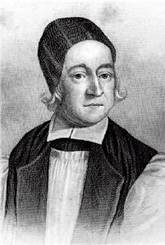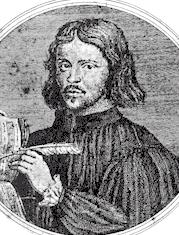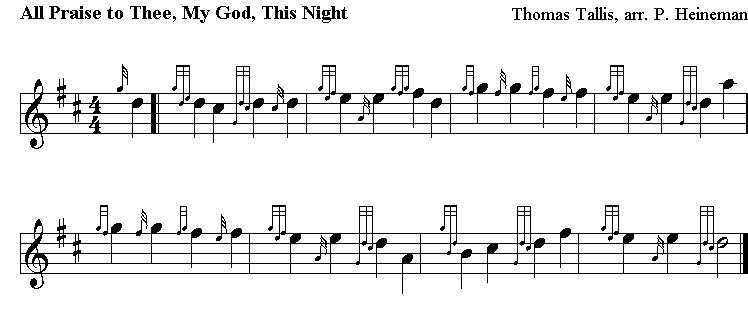
Best viewed in
Internet Explorer
Music (PDF)
Midi
Music (BMW)
Back to

Updated
09/03/2020 |
All Praise to
Thee, My God, This Night

Thomas Ken |
The lyrics to “All Praise to Thee, My God, This Night”
were written by Thomas Ken. Thomas
Ken (July 1637 –
19 March 1711)
was an English cleric who was considered the most eminent of the
English non-juring bishops, and one of the fathers of modern
English hymnology.
Ken was born in 1637 at Little
Berkhampstead, Hertfordshire. His father was Thomas Ken of
Furnival's Inn, of the Ken family of Ken Place, in Somerset; his
mother was the daughter of little known English poet, John
Chalkhill. In 1646 Ken's stepsister, Anne, married Izaak Walton,
author of The Compleat Angler, a connection which brought
Ken under the influence of this gentle and devout man.
In 1652 Ken entered Winchester
College, and in 1656 became a student of Hart Hall, Oxford. He
gained a fellowship at New College in 1657, and proceeded B.A.
in 1661 and M.A. in 1664. He was for some time tutor of his
college; but the most characteristic reminiscence of his
university life is the mention made by Anthony Wood that in the
musical gatherings of the time Thomas Ken of New College, a
junior, would be sometimes among them, and sing his part.
Ordained in 1662, he successively held the livings of Little
Easton in Essex, St. Mary's Church, Brighstone (sometimes called
Brixton) in the Isle of Wight, and East Woodhay in Hampshire; in
1672 he resigned the last of these, and returned to Winchester,
being by this time a prebendary of the cathedral, and chaplain
to the bishop, as well as a fellow of Winchester College. |

Thomas Tallis
|
He remained there for several years, acting
as curate in one of the lowest districts, preparing his Manual of
Prayers for the use of the Scholars of Winchester College (first
published in 1674), and composing hymns. It was at this time that he
wrote, primarily for the same body as his prayers, his morning, evening
and midnight hymns, the first two of which, beginning "Awake, my soul,
and with the sun" and "Glory to Thee, my God, this night," are well
known. The latter is often made to begin with the line "All praise to
Thee, my God, this night," but in the earlier editions over which Ken
had control, the line is as first given. Both of these hymns end with a
doxology beginning "Praise God, from whom all blessings flow," which is
widely sung today by itself, often to the tune Old 100th.
In 1674 Ken paid a visit to Rome in company
with young Izaak Walton, and this journey seems mainly to have resulted
in confirming his regard for the Anglican communion.
In 1679 Ken was appointed by
Charles II chaplain to the Princess Mary, wife of
William of Orange. While with the court at the Hague, he
incurred the displeasure of William by insisting that a
promise of marriage, made to an English lady of high
birth by a relative of the prince, should be kept; and
he therefore gladly returned to England in 1680, when he
was immediately appointed one of the king's chaplains.
He was once more residing at
Winchester in 1683 when Charles came to the city with
his slightly disreputable court. His residence was
chosen as the home of Nell Gwynne, the King's official
mistress—hardly an appropriate arrangement! But Ken
stoutly objected and succeeded in making the favorite
find quarters elsewhere. In August of this same year he
accompanied Lord Dartmouth to Tangier as chaplain to the
fleet, and Pepys, who was one of the company, has left
on record some quaint and kindly reminiscences of him
and of his services on board.
The fleet returned in April
1684, and a few months after, upon a vacancy occurring
in the see of Bath and Wells, Ken (now Dr Ken) was
appointed bishop. It is said that, upon the, occurrence
of the vacancy, the King, mindful of the spirit he had
shown at Winchester, exclaimed, "Where is the good
little man that refused his lodging to poor Nell?" and
determined that no other should be bishop. The
consecration took place at Lambeth on
25
January 1685; and one of Ken's first duties was
to attend the death-bed of Charles, where his wise and
faithful ministrations won the admiration of everybody
except Bishop Burnet.
In this year he published
his Exposition on the Church Catechism, perhaps
better known by its sub-title, The Practice of Divine
Love.
In 1688, when James
reissued his Declaration of Indulgence, Ken was
one of the seven bishops who refused to publish it. He
was probably influenced by two considerations: first, by
his profound aversion from Roman Catholicism, to which
he felt he would be giving some Episcopal recognition by
compliance; but, second and more especially, by the
feeling that James was compromising the spiritual
freedom of the church. Along with his six brethren, Ken
was committed to the Tower on
8
June 1688, on a charge of high misdemeanor; the
trial, which took place on
29 June
and 30
June, and which resulted in a verdict of
acquittal, is a matter of history.
With the Glorious
Revolution which speedily followed this impolitic trial,
new troubles encountered Ken; for, having sworn
allegiance to James, he thought himself thereby
precluded from taking the oath to William of Orange.
Accordingly, he took his place among the non-jurors,
and, as he stood firm to his refusal, he was, in August
1691, superseded in his bishopric by Dr Richard Kidder,
dean of Peterborough. From this time he lived mostly in
retirement, finding a congenial home with Lord Weymouth,
his friend from college days, at Longleat in Wiltshire;
and though pressed to resume his diocese in 1703, upon
the death of Bishop Kidder, he declined, partly on the
ground of growing weakness, but partly no doubt from his
love for the quiet life of devotion which he was able to
lead at Longleat. His death took place there on
19
March 1711. and at dawn the following day, whilst
his faithful friends sang "Awake, my soul, and with the
sun" Bishop Ken's remains were laid to rest beneath the
East Window of the Church of St. John in Frome - the
nearest parish in his old Diocese of Bath and Wells. "I
am dying," Ken had written, "In the Holy, Catholic and
Apostolic Faith professed by the whole Church before the
disunion of East and West; and, more particularly, in
the Communion of the Church of England, as it stands
distinguished from both Papal and Protestant innovation,
and adheres to the Doctrine of the Cross." There is no
finer statement of the Anglican position to be found
anywhere.
He was buried at the Church
of St. John the Baptist, Frome where his crypt can still
be seen. He is remembered in the Church of England with
a Lesser Festival on
8 June.
The music was
written by Thomas Tallis. Tallis (c. 1505 – 23 November 1585) was an
English composer who flourished as a church musician during the often
stormy 16th century in England. He occupies a primary place in
anthologies of English church music, and is considered among the best of
its earliest composers. Tallis has been said to be one of the most
important composers of his time and is honored for his original voice in
English musicianship.
Little is known about Tallis's
early life, but there seems to be agreement that he was
born in the early 16th century, toward the close of the
reign of Henry VII. His first known appointment to a
musical position was as organist of Dover Priory in
1530-31, a Benedictine priory at Dover (now Dover
College) in 1532. His career took him to London, then
(probably in the autumn of 1538) to the Augustinian
abbey of Holy Cross at Waltham until the abbey was
dissolved in 1540; then he went to Canterbury Cathedral,
and finally to Court as Gentleman of the Chapel Royal in
1543, composing and performing for Henry VIII during
which he wrote music for the Church of England, Edward
VI (1547-1553), Queen Mary (1553-1558), and Queen
Elizabeth I (1558 until he died in 1585). Throughout his
service to successive monarchs as organist and composer,
Tallis avoided the religious controversies that raged
around him, though, like William Byrd, he stayed an
"unreformed Roman Catholic."
Tallis married around 1552;
his wife, Joan, outlived him by four years. They
apparently had no children. Late in his life he lived in
Greenwich, likely close to the royal palace: a local
tradition holds that he lived on Stockwell Street.
The earliest surviving works
by Tallis, Salve intemerata virgo, Ave rosa
sine spinis and Ave Dei patris filia are
devotional antiphons to the Virgin Mary, which were used
outside the liturgy and were cultivated in England until
the fall of Cardinal Wolsey. Henry VIII's break with
Roman Catholicism in 1534 and the rise of Thomas Cranmer
noticeably influenced the style of music written. Texts
became largely confined to the liturgy. The writing of
Tallis and his contemporaries became less florid.
Tallis's Mass for four voices is marked with tendencies
toward a syllabic and chordal style and a diminished use
of melisma. Tallis provides a rhythmic variety and
differentiation of moods depending on the meaning of his
texts. Tallis helped found a relationship that was
specific to the combining of words and music.
The reformed Anglican liturgy
was inaugurated during the short reign of Edward VI
(1547-1553), and Tallis was one of the first church
musicians to write anthems set to English words,
although Latin continued to be used. The Catholic Mary
Tudor set about undoing the religious reforms of the
preceding decades. Following the accession of the
Catholic Mary in 1553, the Roman Rite was restored and
compositional style reverted to the elaborate writing
prevalent early in the century. Two of Tallis's major
works, Gaude gloriosa Dei Mater and the Christmas
Mass Puer natus est nobis are believed to be from
this period. Only Puer natus est nobis can be
accurately dated in 1554. As was the prevailing
practice, these pieces were intended to exalt the image
of the Queen as well as to praise the Mother of God.
Elizabeth succeeded her
half-sister in 1558, and the Act of Settlement in the
following year abolished the Roman Liturgy and firmly
established the Book of Common Prayer. Composers at
court resumed writing English anthems, although the
practice of setting Latin texts continued, growing more
peripheral over time.
The mood of the country in
the beginning of Elizabeth's reign leant toward the
puritan, which discouraged the liturgical polyphony.
Tallis wrote nine psalm chant tunes for four voices for
Archbishop Parker's Psalter, published in 1567. One of
the nine tunes, the "Third Mode Melody", inspired the
composition of Fantasia on a Theme of Thomas Tallis
by Ralph Vaughan Williams in 1910. Tallis's better-known
works from the Elizabethan years include his settings of
the Lamentations (of Jeremiah the Prophet) for
the Holy Week services and the unique motet Spem in
alium written for eight five-voice choirs. It is
thought that this 40-voice piece was part of a
celebration of the Queen's 40th birthday in 1573. Tallis
is mostly remembered for his role in composing office
hymns and this motet, Spem in alium.
Toward the end
of his life, Tallis resisted the musical
development seen in his younger
contemporaries such as William Byrd, who
embraced compositional complexity and
adopted texts built by combining
disparate biblical extracts. Tallis'
experiments during this time period were
considered rather unusual). Tallis was
content to draw his texts from the
Liturgy and wrote for the worship
services in the Chapel Royal . In 1543,
he probably began to serve full time as
a member of the Chapel Royal. The Chapel
Royal later became a Protestant
establishment. Tallis has been variously
claimed to be a Protestant, Catholic,
and a religious Pragmatist. Mary granted
him a lease on a manor in Kent that
provided a comfortable annual income.
Elizabeth granted to Tallis and Byrd a
twenty-one year monopoly in 1575 for
polyphonic music and a patent to print
and publish music, which was one of the
first arrangements of that type in the
country. Tallis' monopoly covered 'set
songe or songes in parts, and he was
able to compose in English, Latin,
French, Italian, or other tongues as
long as they served for music in the
Church or chamber. Tallis had exclusive
rights to print any music, in any
language. He and William Byrd were the
only ones allowed to use the paper that
was used in printing music. Tallis and
Byrd used their monopoly to produce
Cantiones quae ab argumento sacrae
vocantur but the piece did not sell well
and they appealed to Queen Elizabeth for
her support. Tallis and Byrd could work
for two opposing religions as long as
they did not bring their beliefs into
their jobs. He retained respect during a
succession of opposing religious
movements and deflected the violence
that claimed Catholics and Protestants
alike. Tallis endured a difficult period
during the time of the church and his
music often displays characteristics of
the turmoil.
Thomas Tallis
died peacefully in his house in
Greenwich in November 1585 on either the
20th or 23rd. He was buried in the
chancel of the parish of St Alfege's
Church. A couplet from his epitaph
reads:
As he
did live, so also did he die, In
mild and quiet Sort (O! happy Man).

Lyrics by Thomas Ken
|
|
All praise to Thee, my
God, this night,
For all the blessings of the light!
Keep me, O keep me, King of kings,
Beneath Thine own almighty wings.
Forgive me, Lord, for
Thy dear Son,
The ill that I this day have done,
That with the world, myself, and Thee,
I, ere I sleep, at peace may be.
Teach
me to live, that I may dread
The grave as little as my bed.
Teach me to die,
that so I may
Rise glorious at the judgment day. |
O may my soul on Thee
repose,
And with sweet sleep mine eyelids close,
Sleep that may me more vigorous make
To serve my God when I awake.
When in the night I
sleepless lie,
My soul with heavenly thoughts supply;
Let no ill dreams disturb my rest,
No powers of darkness me molest.
O
when shall I, in endless day,
For ever chase dark sleep away,
And hymns divine with angels sing,
All praise to thee, eternal King? |
|




